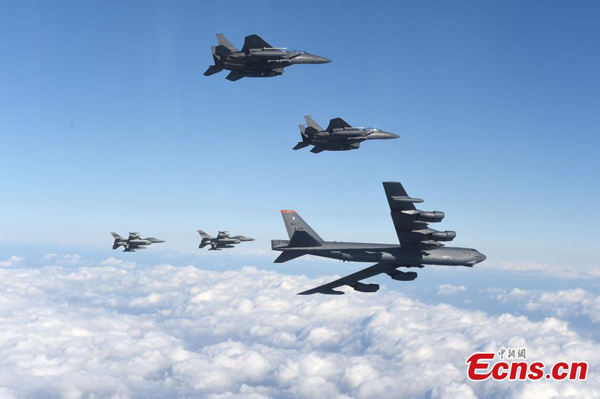
Photo taken on January 10, 2016 shows a U.S. B-52 Stratofortress (bottom R) flying with South Korean F-15K fighter jets (top) and U.S. F-16 fighter jets (bottom L) over South Korea. (Photo/Agencies)
A U.S. B-52 bomber, capable of delivering nuclear missile, flied on Sunday over the airspace of the Republic of Korea (ROK) in response to the Democratic People's Republic of Korea's (DPRK) fourth nuclear test, Combined Forces Command (CFC) said.
The CFC said in a statement that the B-52 bomber conducted a low-level flight mission in the vicinity of Osan, 40 km south of Seoul, in response to the DPRK's "recent provocative action."
The long-range bomber, which departed from the U.S. Anderson Air Force Base in Guam on Sunday morning, arrived and flied over the ROK's Osan Air Base at about noon.
Upon completion of the flight over the ROK, the B-52 returned to Guam, the CFC said.
The flight, which was joined by a ROK F-15k fighter jet and a U.S. F-16 fighter, aimed to demonstrate the U.S. steadfast commitment to the defense of its ally the ROK, the statement said.
"The flight today demonstrates the strength and capabilities of the Alliance," said Gen Curtis Scaparrotti, the U.S. Forces Korea (USFK) commander.
"The close military cooperation between the United States and the ROK ensures we are ready to respond at any time to those who would threaten stability and security," the commander said.
The B-52 bomber can infiltrate at the highest altitude of 55,000 feet, or 16.8 km, carrying 35 conventional bombs and 12 cruise missiles.
It can also deliver air-to-ground nuclear missiles with a range of 200 km and air-launched cruise missiles with a range of 2,500-3,000 km.
The flight came as part of retaliatory measures after the DPRK said Wednesday that it had successfully tested a hydrogen bomb. If confirmed, it would mark the DPRK's first hydrogen bomb test and the fourth in total. Previous tests were conducted in 2006, 2009 and 2013.
In retaliation for the nuclear test, the ROK began blaring propaganda messages at Friday noon from speakers across the border into the DPRK, which called it an "act of declaring war."
The ROK frontline units, near 11 sites where the set of loudspeakers restarted psychological warfare with anti-DPRK messages, have been on the highest alert for any possible DPRK provocations.
"B-52 missions reinforce the U.S. commitment to the security of our allies and partners, and demonstrate one of the many alliance capabilities available for the defense of the ROK," Lt. Gen. Terrence O'Shaughnessy, the USFK deputy commander and U.S. Seventh Air Force commander, said.
The U.S. and the ROK militaries are reportedly considering additional retaliatory measures, which include the deployment in the ROK of the U.S. aircraft carrier Ronald Reagan currently in Yokosuka, Japan.
The retaliation also includes the deployment of a U.S. nuclear-powered submarine and F-22 stealth fighter.


















































